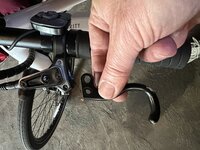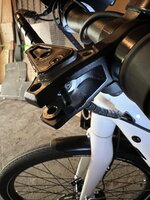mojoe
Active Member
- Region
- USA
Thanks for the update. That's a bummer about the cable routing. I just measured the space on my bike and it is 5 mm or less. Is that a disconnect plug that you show in the picture? It looks like without the plug, the cable might fit into that tiny space next to the down tube.
You're correct about the video, I watched it, too. They must have changed something since then. They should change it back, to allow more room for the wiring and plug. I've noticed that some of the videos are obviously older than others, as you can see differences in the bikes.
Good to know that the battery can be easily disassembled. The main battery doesn't look too difficult, either. It will be a long time, but it's nice to know that the packs are easily rebuilt when the time comes.
Actually, if the extender battery comes apart that easily, it may not be too much trouble to disconnect the wiring at that end, so that it can be routed through the hole, as it should be. Even with the plastic loom over the wiring, I'd want to put some additional heatshrink or something at that point, for wear. Maybe the best thing to do is drill or grind a larger hole, and use a beefy rubber grommet to prevent abrasion. My bike is black, so it wouldn't be as noticeable as on your white one.
If I get my 3D printer repaired, I may take a stab at making a cover for the exposed terminals when the battery is removed. I'm having trouble finding the correct size sleeve bearing for the 3D printer. In the mean time, perhaps a block of dense foam could be cut to fit there (not Styrofoam).
You're correct about the video, I watched it, too. They must have changed something since then. They should change it back, to allow more room for the wiring and plug. I've noticed that some of the videos are obviously older than others, as you can see differences in the bikes.
Good to know that the battery can be easily disassembled. The main battery doesn't look too difficult, either. It will be a long time, but it's nice to know that the packs are easily rebuilt when the time comes.
Actually, if the extender battery comes apart that easily, it may not be too much trouble to disconnect the wiring at that end, so that it can be routed through the hole, as it should be. Even with the plastic loom over the wiring, I'd want to put some additional heatshrink or something at that point, for wear. Maybe the best thing to do is drill or grind a larger hole, and use a beefy rubber grommet to prevent abrasion. My bike is black, so it wouldn't be as noticeable as on your white one.
If I get my 3D printer repaired, I may take a stab at making a cover for the exposed terminals when the battery is removed. I'm having trouble finding the correct size sleeve bearing for the 3D printer. In the mean time, perhaps a block of dense foam could be cut to fit there (not Styrofoam).



